
Europe and Mediterranean: Mediterranean Solar Eclipse with Barcelona Overnight Cruise
Holland America Line
View the 2026 Solar Eclipse from the roomy deck of the cruise ship, off the coast of Spain. Other highlights include an overnight stay in Barcelona and a visit to Bari.

Executive Member Benefit
Executive Members receive an annual 2% Reward, up to $1,250, on qualified Costco Travel purchases
Digital Costco Shop Card
Member Exclusive: Digital Costco Shop Card with every Holland America Line sailing†
Sailing Itinerary

Note: Cruise itineraries are subject to change. Please verify ports and times directly with the cruise line.
Overview
Lisbon is Portugal’s hilly, coastal capital city. From the imposing São Jorge Castle, the view encompasses the old city’s pastel-colored buildings, Tagus Estuary, and Ponte 25 de Abril suspension bridge. Nearby, the National Azulejo Museum displays 5 centuries of decorative ceramic tiles. Just outside Lisbon is a string of Atlantic beaches, from Cascais to Estoril.
Overview
Lying on the Eastern coast of Spain, Alicante has it all: parties, discos, festivals, castles - and if that isn't enough - hot sun, white sand beaches, and a turquoise sea. Of course, something so good can't stay hidden forever, and Alicante and the towns along the Costa Blanca (White Coast) are now among Europe's most heavily visited regions. If you want a secluded beach, or to be anywhere outdoors without being part of a crowd, don't come during the summer high season. But if you're looking for sunshine, all-night disco parties, and hundreds of thousands of potential new friends, you've come to the right place. It's best to start exploring Alicante on the beachfront, along the city's main pedestrian walkway, the Expanada de Espana. Spread out in front of the main part of the city, this elegant boulevard, stretching around the harbor, is shaded with palm trees and lined with shops and cafes. Amid this Mediterranean Xanadu, there is, sadly, one note of warning: be especially wary here of pickpockets and bag snatchers. Northwest of the Explanada, towards the center of the city, you'll see the imposing Catedral de San Nicolas, and around it, the narrow streets of the El Barro, or old quarter, which has most of the cheaper accommodation and the best nightlife. To the southwest, near the Calle de Italia, you'll find the main tourist office, post office, and the city's central bus and train stations. Alicante is a hive of activity throughout the year, not just in the summer months. It's a city where the sand seems to go on forever…and so does the entertainment. It's a city steeped in history, rich in culture, awash with every kind of shop and restaurant imaginable, and bursting with beach life. Stroll along the palm-fringed Paseo de la Explanada - the impressive seafront promenade lined with street cafes and inlaid with red, cream, and black marble. Stop at the music pavilion and enjoy a free al fresco concert by the sea. Concerts are held in the afternoons, on feast days, and on Sunday mornings during the summer months.
Overview
Barcelona is a charming, cosmopolitan port on the shores of the Mediterranean Sea. This prosperous and bilingual (Spanish and Catalan) metropolis measures up to a city such as Madrid: its museums, theaters, art galleries, and nightlife area are of an impressively high standard. Besides that, this art and design center has a lot of interesting sights to offer to its visitors. The best place to watch people go by, stroll, or simply relax, is 'Las Ramblas', a pedestrian street with dozens of outdoor cafes. Here, you’ll find flower stands, book kiosks, and small market stalls where they sell birds and small animals. You’ll also find an endlessly fascinating flowing receptacle of pageant jugglers, singers, dancers, puppeteers, sidewalk artists, living statues, and assorted oddballs on parade. Nearby is 'Place Real', with plenty of bars and restaurants, and 'Palau Guell', built by the Catalan architectural genius Antoni Gaudi in his undulating art-nouveau style. After having seen these sights, stroll the narrow winding streets of the 'Barri Gotic', the medieval Gothic quarter full of interesting tapas bars, and cafes. Check out Picasso’s old hangout, 'Els Quatre Gats', which has been renovated without losing its bohemian charm. Or head for the old Barceloneta section on the waterfront. This working-class area, which was always slightly rundown and scruffy-looking, is now packed with paella restaurants. The new beach area, which runs from Barceloneta to the Olympic Village, is much cleaner than the old beach area. Although some people believe that it has been cleaned up considerably, it might be a wise idea to stay out of the water. Fortunately, the beach itself is already a feast for the eyes (and ears), with its huge and roaring waves.
Overview
Barcelona is a charming, cosmopolitan port on the shores of the Mediterranean Sea. This prosperous and bilingual (Spanish and Catalan) metropolis measures up to a city such as Madrid: its museums, theaters, art galleries, and nightlife area are of an impressively high standard. Besides that, this art and design center has a lot of interesting sights to offer to its visitors. The best place to watch people go by, stroll, or simply relax, is 'Las Ramblas', a pedestrian street with dozens of outdoor cafes. Here, you’ll find flower stands, book kiosks, and small market stalls where they sell birds and small animals. You’ll also find an endlessly fascinating flowing receptacle of pageant jugglers, singers, dancers, puppeteers, sidewalk artists, living statues, and assorted oddballs on parade. Nearby is 'Place Real', with plenty of bars and restaurants, and 'Palau Guell', built by the Catalan architectural genius Antoni Gaudi in his undulating art-nouveau style. After having seen these sights, stroll the narrow winding streets of the 'Barri Gotic', the medieval Gothic quarter full of interesting tapas bars, and cafes. Check out Picasso’s old hangout, 'Els Quatre Gats', which has been renovated without losing its bohemian charm. Or head for the old Barceloneta section on the waterfront. This working-class area, which was always slightly rundown and scruffy-looking, is now packed with paella restaurants. The new beach area, which runs from Barceloneta to the Olympic Village, is much cleaner than the old beach area. Although some people believe that it has been cleaned up considerably, it might be a wise idea to stay out of the water. Fortunately, the beach itself is already a feast for the eyes (and ears), with its huge and roaring waves.
Overview
Located on the west coast of the island of Corsica, the capital city of Ajaccio is famous as the birthplace of Napoleon Bonaparte. This Mediterranean port town enjoys an exceptionally mild climate and offers travelers several cafes, restaurants, and shops to enjoy in addition to several interesting sites, including the Cathedrale Notre-Dame de la Misericorde, where Napoleon was baptized in 1771, and the Chapelle Imperiale, built-in 1855 by Napoleon III to accommodate the tombs of the Bonaparte family. Impressive views of the town can be enjoyed from the Jetee de la Citadelle, located next to the 16th-century citadel currently occupied by the army.
Overview
Located about 80 kilometers northwest of Rome, the Port of Civitavecchia is the port of Rome and a busy ferry and cargo port serving Italy and southern Europe. Lying on Italy’s eastern shores on the Tyrrhenian Sea, the Port of Civitavecchia has excellent direct connections to Rome. It is an important cruise and ferry port with regular passage to Sardinia, Malta, Sicily, Tunis, and Barcelona. Fishing is of secondary importance to the Port of Civitavecchia. In addition to ocean-going traffic, the Port of Civitavecchia also contains a thermoelectric center and metallurgical works. In 2006, over 51 thousand people called the Port of Civitavecchia home. The Port of Civitavecchia was built on an earlier Etruscan settlement. Emperor Trajan founded the Port of Civitavecchia in the early 2nd Century, calling it Centumcellae. Today, Trajan’s Port is preserved within today’s Port of Civitavecchia. A busy growing town during the late Roman era, the Port of Civitavecchia was attacked by Vandals and then destroyed by the Saracens in 828 AD. Residents escaped to the nearby Allumiere Mountains where Pope Leo IV built a walled town in 854. Eventually, the people returned to Civitavecchia (the name means “old city”). At the end of the 15th Century, the Port of Civitavecchia was under frequent attack by pirates. The naval arsenal was constructed in 1508. Pope Paul III commissioned the building of the keep, which was designed by Donato Bramante and then finished by Michelangelo in 1537, to protect the Port of Civitavecchia from pirate attacks. In 1696, Civitavecchia became a free port under Pope Innocent XII. Because it was Rome’s main port, the French occupied the Port of Civitavecchia in 1849. The Port of Civitavecchia was linked to Rome by the Rome and Civitavecchia Rail Road in 1859. When the Port of Civitavecchia became part of the Kingdom of Italy in 1870, it was one of the Papal State’s most strongly fortified towns when Papal troops welcomed General Nino Bixio on behalf of the Italian unification forces into the Port of Civitavecchia fortress. World War II brought destruction to as much as three-quarters of the Port of Civitavecchia. Reconstruction enlarged the Port of Civitavecchia beyond its pre-war area. The Authority Portuale Civitavecchia (Port of Rome) is responsible for managing and operating the Port of Civitavecchia as well as the ports of Fiumicino and Gaeta. The modern Port of Civitavecchia is at the center of rail, road, and air networks that link it with central Italy and the world. The Port of Civitavecchia can handle about 11 million tons of cargo per year and over 1.5 million passengers. Cargoes include forest products, cereals, iron and steel, chemicals, automobiles, containers, and liquid bulk. In 2007, the Port of Civitavecchia welcomed 856 cruise vessels carrying 1.6 million passengers, and the total number of passengers using ferries and cruise vessels was 3.8 million. In 2007, the Port of Civitavecchia handled a total of 7.7 million tons of cargo. This total included 1.5 million tons of liquid bulk, 1.7 million tons of solid bulk, 4.6 million tons of packages, and 31.1 thousand TEUs of containerized cargo. The Port of Civitavecchia contains 28 berths of a total of 5.6 thousand meters in length alongside depths from 6 to 18 meters. Port properties include five warehouses containing 36 thousand square meters for handling and storing cargo. The intermodal terminal includes seven thousand square meters of storage space and 12.5 thousand square meters for loading/unloading rail cars and parking. The Port of Civitavecchia is one of the busiest ferry ports in the world. Just 80 kilometers northwest of Rome, it is the main tourist destination for people traveling to the Eternal City. It is also a central port for ferries carrying passengers to more local destinations. The ferry terminal offers a complete line of amenities. Different ferry companies offer services to various destinations. Moby Lines handles crossings to Olbia, Sardinia. Corsica Sardinia Ferries runs services to Golfo Aranci. Grimaldi Ferries carries passengers to Barcelona and Tunis, and Grand Navi Veloci operates a route to Tunis. Ferrovie dello Stato operates a combined rail-ferry service to Golfo Aranci.
Overview
Bari is a port city on the Adriatic Sea and the capital of southern Italy’s Puglia region. Its mazelike old town, Barivecchia, occupies a headland between 2 harbors. Surrounded by narrow streets, the 11th-century Basilica di San Nicola, a key pilgrimage site, holds some of St. Nicholas’ remains. To the south, the Murat Quarter has stately 19th-century architecture, a promenade, and pedestrianized shopping areas.
Overview
Kotor is a fortified town on Montenegro’s Adriatic coast, in a bay near the limestone cliffs of Mt. Lovcen. Characterized by winding streets and squares, its medieval old town has several Romanesque churches, including Kotor Cathedral. It's also home to the Maritime Museum, which explores local seafaring history. Sveti Ðorde, one of 2 tiny islands off the ancient town of Perast, features a centuries-old church.
Overview
Today Piraeus is the home base of Greek shipping, the largest commercial fleet in the world, apace bound to the sea like few others. The harbors of Zea and Mikrolimano as well as Phaliro play host to countless yachts and sailing craft throughout the year. Piraeus was known in medieval times as Porto Leone, a name due to the enormous stone lion, which guarded the port's entrance. Today, the life of Piraeus is centered on its three ports: the main, central one, and those of Zea and Mikrolimano. You can walk around the central harbor, shared by cargo and passenger ships alike, and watch the constant comings and goings of goods and people from around the world. Having completed your tour of the central harbor of Piraeus you will then head south traversing the peninsula and arriving at Peiraiki, one of the most picturesque neighborhoods in the city. Here one finds the harbor of Zea, one of the largest marinas in the Mediterranean. If the night finds you in the area, you can try one of the many bars found nearby. You can continue your tour along the waterfront heading towards Kastella but a small deviation toward the city center will be useful for then you can visit the verdant square of the municipal Theatre with cafeterias and shops of all kinds surrounding it. The magnificent building housing the Municipal Theatre as well as the Town Hall and the Library complete the picture presented by the main square in the city. Piraeus's little natural harbors are among its busiest and most touristy areas: Mikrolimano, Passalimani, Zea, Freatida, and Hatzikiriakio. Countless seaside tavernas provide delicious seafood washed down with the uniquely Greek drink, ouzo. The fresh smell of the sea and the sounds made by the assortment of caiques, yachts, and sailing ships, which are moored next to the tables, complete the enjoyment of the food Beyond the port, the most impressive spots are the hills of Profitis Ilias and Kastela with their neoclassical mansions and modern buildings which look as they are hanging over the sea.
Onboard the Oosterdam
Oosterdam
Year Built: 2003
Year Refurbished: 2016
Double Occupancy Capacity: 1916
Holland America Line’s first Vista-class cruise ship, Oosterdam has delighted guests since her maiden voyage. Guests now have more world-class entertainment options than ever before. Live music has always been the heart and soul of evenings aboard Holland America Line, and now Oosterdam features the full Music Walk experience with three exciting venues. Lincoln Center Stage features world-class musicians performing chamber music. Billboard Onboard, rocks the house with 50 years of chart-topping hits. The already popular B.B. King’s Blues Club, brings the best of Memphis blues to sea. Feel free to enjoy exciting activities, pursue new interests or simply relax and rejuvenate.
Activities & Services (included in cruise)

Digital Workshop
- Card Room
- Casino
- Disco/Nightclub
- Game Arcade
- Movies
- Theater/Show Lounge
- Fitness Center
- Sauna/Steam Room
- Culinary Arts Center
- Educational Programs
- Pool - Outdoor
- Sports Facilities
- Whirlpool/Jacuzzi
- Art Gallery
- Bars/Lounges
- Library
- Children's Indoor Play Area
- Organized Age Specific Activities
- Teen Center or Disco
- Teen Programs
- Business Center
- Concierge Desk
- Duty-Free Shops/Boutiques
- Elevators
- Safe Deposit Boxes
Activities & Services (available for an extra fee)

Greenhouse Spa
- Beauty Salon
- Full-Service Spa
- Internet Center
- Babysitting
- Dry Cleaning/ Laundry Service
- Infirmary/Medical Center

Dining Room
Main Dining
Dining Room: For breakfast, lunch or an unforgettable five-course dinner, the elegant main Dining Room is your destination for sophisticated dining, with menu selections from classic favorites to vegetarian options, to dishes inspired by the regions you’ll visit.

Pinnacle Grill
Specialty Dining
Pinnacle Grill: Enjoy dishes inspired by America’s Pacific Northwest, such as king salmon from Alaska and choice, responsibly raised beef from Washington State’s Double R Ranch. Complement your meal with a selection of boutique wines from the Pacific Northwest and other celebrated vineyards from around the world. This restaurant is available for an additional cost.
Canaletto: This authentic Italian restaurant offers a menu that celebrates spartire (Italian for "sharing"). Try braised chicken cacciatore "al forno," branzino ai ferri or a classic Italian pasta: spaghetti pomodoro or garlic shrimp-infused ravioli, perhaps. Buon appetito! This restaurant is available for an additional cost.

Room Service
Casual Dining
Lido Market: Lido Market provides a fresh, new approach to casual dining for breakfast, lunch or dinner, with a panoramic view of the sea. A modern marketplace with different themed stations, the Lido offers a curated selection of delicious options to grab on the go or to have quickly made to order.
Dive-In: Dive in to a grilled burger on brioche or a Nathan’s Famous gourmet hot dog. For alfresco dining by the pool, Dive-In has it all, including lighter fare like the grilled chicken breast sandwich and vegetarian-friendly portabella mushroom stack.
Explorations Café: A comfortable, coffeehouse environment offering espresso drinks and pastries. This restaurant is available for an additional cost.
Room Service: Complimentary 24-hour dining in the comfort of your stateroom.
Staterooms feature premium massage showerheads, fine linens and fresh fruit upon request.
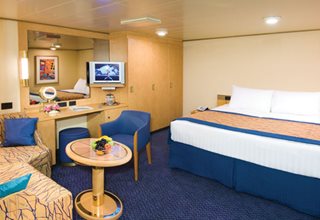
Category: N
Amenities- Daily housekeeping
- Complimentary 24-hour room service
- Elemis Aromapure soap, lotion, shampoo
- Luxurious bathrobes
- Hair dryers, makeup mirrors
- Generous storage
- Fresh fruit upon request
- Safe
- Ice service
- Shoeshine
- TV with On Demand movies, programming

Category: MM
Amenities- Daily housekeeping
- Complimentary 24-hour room service
- Elemis Aromapure soap, lotion, shampoo
- Luxurious bathrobes
- Hair dryers, makeup mirrors
- Generous storage
- Fresh fruit upon request
- Safe
- Ice service
- Shoeshine
- TV with On Demand movies, programming

Category: M
Amenities- Daily housekeeping
- Complimentary 24-hour room service
- Elemis Aromapure soap, lotion, shampoo
- Luxurious bathrobes
- Hair dryers, makeup mirrors
- Generous storage
- Fresh fruit upon request
- Safe
- Ice service
- Shoeshine
- TV with On Demand movies, programming

Category: L
Amenities- Daily housekeeping
- Complimentary 24-hour room service
- Elemis Aromapure soap, lotion, shampoo
- Luxurious bathrobes
- Hair dryers, makeup mirrors
- Generous storage
- Fresh fruit upon request
- Safe
- Ice service
- Shoeshine
- TV with On Demand movies, programming

Category: K
Amenities- Daily housekeeping
- Complimentary 24-hour room service
- Elemis Aromapure soap, lotion, shampoo
- Luxurious bathrobes
- Hair dryers, makeup mirrors
- Generous storage
- Fresh fruit upon request
- Safe
- Ice service
- Shoeshine
- TV with On Demand movies, programming

Category: J
Amenities- Daily housekeeping
- Complimentary 24-hour room service
- Elemis Aromapure soap, lotion, shampoo
- Luxurious bathrobes
- Hair dryers, makeup mirrors
- Generous storage
- Fresh fruit upon request
- Safe
- Ice service
- Shoeshine
- TV with On Demand movies, programming

Category: I
Amenities- Daily housekeeping
- Complimentary 24-hour room service
- Elemis Aromapure soap, lotion, shampoo
- Luxurious bathrobes
- Hair dryers, makeup mirrors
- Generous storage
- Fresh fruit upon request
- Safe
- Ice service
- Shoeshine
- TV with On Demand movies, programming
Elegant staterooms feature luxurious bedding, premium massage showerheads, a porthole or a window and fresh fruit upon request.
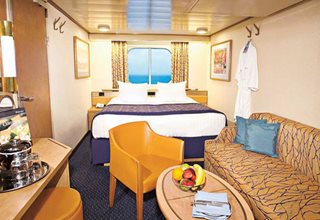
Category: HH
Amenities- Daily housekeeping
- Complimentary 24-hour room service
- Elemis Aromapure soap, lotion, shampoo
- Luxurious bathrobes
- Hair dryers, makeup mirrors
- Generous storage
- Fresh fruit upon request
- Safe
- Ice service
- Shoeshine
- TV with On Demand movies, programming

Category: H
Amenities- Daily housekeeping
- Complimentary 24-hour room service
- Elemis Aromapure soap, lotion, shampoo
- Luxurious bathrobes
- Hair dryers, makeup mirrors
- Generous storage
- Fresh fruit upon request
- Safe
- Ice service
- Shoeshine
- TV with On Demand movies, programming

Category: G
Amenities- Daily housekeeping
- Complimentary 24-hour room service
- Elemis Aromapure soap, lotion, shampoo
- Luxurious bathrobes
- Hair dryers, makeup mirrors
- Generous storage
- Fresh fruit upon request
- Safe
- Ice service
- Shoeshine
- TV with On Demand movies, programming

Category: F
Amenities- Daily housekeeping
- Complimentary 24-hour room service
- Elemis Aromapure soap, lotion, shampoo
- Luxurious bathrobes
- Hair dryers, makeup mirrors
- Generous storage
- Fresh fruit upon request
- Safe
- Ice service
- Shoeshine
- TV with On Demand movies, programming

Category: E
Amenities- Daily housekeeping
- Complimentary 24-hour room service
- Elemis Aromapure soap, lotion, shampoo
- Luxurious bathrobes
- Hair dryers, makeup mirrors
- Generous storage
- Fresh fruit upon request
- Safe
- Ice service
- Shoeshine
- TV with On Demand movies, programming

Category: DD
Amenities- Daily housekeeping
- Complimentary 24-hour room service
- Elemis Aromapure soap, lotion, shampoo
- Luxurious bathrobes
- Hair dryers, makeup mirrors
- Generous storage
- Fresh fruit upon request
- Safe
- Ice service
- Shoeshine
- TV with On Demand movies, programming

Category: D
Amenities- Daily housekeeping
- Complimentary 24-hour room service
- Elemis Aromapure soap, lotion, shampoo
- Luxurious bathrobes
- Hair dryers, makeup mirrors
- Generous storage
- Fresh fruit upon request
- Safe
- Ice service
- Shoeshine
- TV with On Demand movies, programming

Category: C
Amenities- Daily housekeeping
- Complimentary 24-hour room service
- Elemis Aromapure soap, lotion, shampoo
- Luxurious bathrobes
- Hair dryers, makeup mirrors
- Generous storage
- Fresh fruit upon request
- Safe
- Ice service
- Shoeshine
- TV with On Demand movies, programming
Spacious staterooms have a private balcony, whirlpool bath with shower and walk-in closet.
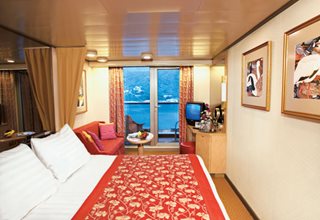
Category: VH
Amenities- Daily housekeeping
- Complimentary 24-hour room service
- Elemis Aromapure soap, lotion, shampoo
- Luxurious bathrobes
- Hair dryers, makeup mirrors
- Generous storage
- Fresh fruit upon request
- Safe
- Ice service
- Shoeshine
- TV with On Demand movies, programming

Category: VF
Amenities- Daily housekeeping
- Complimentary 24-hour room service
- Elemis Aromapure soap, lotion, shampoo
- Luxurious bathrobes
- Hair dryers, makeup mirrors
- Generous storage
- Fresh fruit upon request
- Safe
- Ice service
- Shoeshine
- TV with On Demand movies, programming

Category: VE
Amenities- Daily housekeeping
- Complimentary 24-hour room service
- Elemis Aromapure soap, lotion, shampoo
- Luxurious bathrobes
- Hair dryers, makeup mirrors
- Generous storage
- Fresh fruit upon request
- Safe
- Ice service
- Shoeshine
- TV with On Demand movies, programming

Category: VD
Amenities- Daily housekeeping
- Complimentary 24-hour room service
- Elemis Aromapure soap, lotion, shampoo
- Luxurious bathrobes
- Hair dryers, makeup mirrors
- Generous storage
- Fresh fruit upon request
- Safe
- Ice service
- Shoeshine
- TV with On Demand movies, programming

Category: VC
Amenities- Daily housekeeping
- Complimentary 24-hour room service
- Elemis Aromapure soap, lotion, shampoo
- Luxurious bathrobes
- Hair dryers, makeup mirrors
- Generous storage
- Fresh fruit upon request
- Safe
- Ice service
- Shoeshine
- TV with On Demand movies, programming

Category: VB
Amenities- Daily housekeeping
- Complimentary 24-hour room service
- Elemis Aromapure soap, lotion, shampoo
- Luxurious bathrobes
- Hair dryers, makeup mirrors
- Generous storage
- Fresh fruit upon request
- Safe
- Ice service
- Shoeshine
- TV with On Demand movies, programming

Category: VA
Amenities- Daily housekeeping
- Complimentary 24-hour room service
- Elemis Aromapure soap, lotion, shampoo
- Luxurious bathrobes
- Hair dryers, makeup mirrors
- Generous storage
- Fresh fruit upon request
- Safe
- Ice service
- Shoeshine
- TV with On Demand movies, programming
Luxurious suites feature a whirlpool bath, large sitting area, private balcony, floor-to-ceiling windows and more. Select suites feature a dressing room.
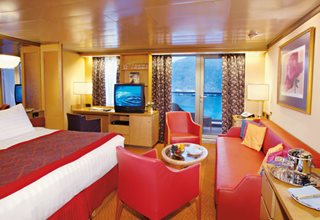
Category: SZ
Amenities- Daily housekeeping
- Complimentary 24-hour room service
- Elemis Aromapure soap, lotion, shampoo
- Luxurious bathrobes
- Hair dryers, makeup mirrors
- Generous storage
- Fresh fruit upon request
- Safe
- Ice service
- Shoeshine
- TV with On Demand movies, programming
- Binoculars
- Whirlpool bath

Category: SY
Amenities- Daily housekeeping
- Complimentary 24-hour room service
- Elemis Aromapure soap, lotion, shampoo
- Luxurious bathrobes
- Hair dryers, makeup mirrors
- Generous storage
- Fresh fruit upon request
- Safe
- Ice service
- Shoeshine
- TV with On Demand movies, programming
- Binoculars
- Whirlpool bath

Category: SS
Amenities- Daily housekeeping
- Complimentary 24-hour room service
- Elemis Aromapure soap, lotion, shampoo
- Luxurious bathrobes
- Hair dryers, makeup mirrors
- Generous storage
- Fresh fruit upon request
- Safe
- Ice service
- Shoeshine
- TV with On Demand movies, programming
- Binoculars
- Whirlpool bath
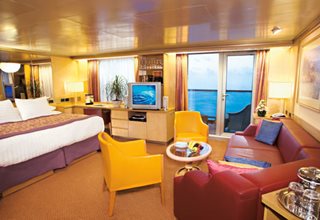
Category: SC
Amenities- Daily housekeeping
- Complimentary 24-hour room service
- Elemis Aromapure soap, lotion, shampoo
- Premium bathrobes, slippers
- Hair dryers, makeup mirrors
- Generous storage
- Fresh fruit upon request
- Safe
- Ice service
- Shoeshine
- TV with On Demand movies, programming
- Fresh flowers
- One-Touch concierge service
- Whirlpool bath (suite dependent)
- In-suite coffee, espresso
- Complimentary laundry
- Pre-dinner hors d'oeuvres served in suite
- Welcome glass of sparkling wine
- Priority boarding for tender ports, priority dining/seating requests, special disembarkation service
- High tea in suite on request
- Binoculars
- Exclusive tote bag

Category: SB
Amenities- Daily housekeeping
- Complimentary 24-hour room service
- Elemis Aromapure soap, lotion, shampoo
- Premium bathrobes, slippers
- Hair dryers, makeup mirrors
- Generous storage
- Fresh fruit upon request
- Safe
- Ice service
- Shoeshine
- TV with On Demand movies, programming
- Fresh flowers
- One-Touch concierge service
- Whirlpool bath (suite dependent)
- In-suite coffee, espresso
- Complimentary laundry
- Pre-dinner hors d'oeuvres served in suite
- Welcome glass of sparkling wine
- Priority boarding for tender ports, priority dining/seating requests, special disembarkation service
- High tea in suite on request
- Binoculars
- Exclusive tote bag

Category: SA
Amenities- Daily housekeeping
- Complimentary 24-hour room service
- Elemis Aromapure soap, lotion, shampoo
- Premium bathrobes, slippers
- Hair dryers, makeup mirrors
- Generous storage
- Fresh fruit upon request
- Safe
- Ice service
- Shoeshine
- TV with On Demand movies, programming
- Fresh flowers
- One-Touch concierge service
- Whirlpool bath (suite dependent)
- In-suite coffee, espresso
- Complimentary laundry
- Pre-dinner hors d'oeuvres served in suite
- Welcome glass of sparkling wine
- Priority boarding for tender ports, priority dining/seating requests, special disembarkation service
- High tea in suite on request
- Binoculars
- Exclusive tote bag
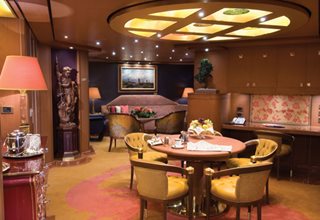
Category: PS

| Symbol | Description |
|---|---|
 | Triple (2 lower beds, 1 sofa bed) |
 | Quad (2 lower beds, 1 sofa bed, 1 upper) |
 | Partial sea view |
 | Fully obstructed view |
 | Connecting rooms |
 | Shower only |
 | Single sink vanity |
 | Staterooms have solid steel verandah railings instead of clear-view plexiglass railings |
 | Suites SC6175 and SC6164 are fully accessible, bathtub and roll-in shower; Suite SS6108 and staterooms I8037, VB6004, VB6003, D1100, C1082, C1081, J1074, K1012, and K1011 are fully accessible, roll-in shower only |
 | Fully accessible with single side approach to the bed, bathtub, and roll-in shower |
 | Ambulatory accessible, roll-in shower only |

- Ship Name: Oosterdam
- Year Built: 2003
- Year Refurbished: 2016
- Year Entered Present Fleet: 2003
- Ship Class: Vista
- Maximum Capacity: 2,504
- Number of Passenger Decks: 11
- Number of Crew: 817
- Officers' Nationality: International
- Ocean-View without Balcony: 165
- Ocean-View with Balcony: 477
- Total Inside Staterooms: 154
- Tonnage (GRT): 82,305
- Capacity Based on Double Occupancy: 1,916
- Country of Registry: Netherlands
- Total Staterooms: 958
- Suites with Balcony: 162
- Crew/Hotel Staff Nationality: International
Costco Member Reviews

Available Dates & Prices
Terms & Conditions
*Price shown is per person based on double occupancy and is valid for select stateroom categories only. Click on the Terms & Conditions link below for details.
†One Digital Costco Shop Card per room/stateroom, per stay. The exact amount of the Digital Costco Shop Card will be calculated during the booking process. The Digital Costco Shop Card promotion is nontransferable and may not be combined with any other promotion. A Digital Costco Shop Card will arrive by email approximately 10 days after the start of your cruise. Click on the Terms & Conditions link below for additional information.
Ship's registry: The Netherlands
Digital Costco Shop Card
This booking includes a Digital Costco Shop Card which will arrive by email one to two weeks after you return from your vacation. The Digital Costco Shop Card is a convenient payment option in our warehouses and on Costco.com.















